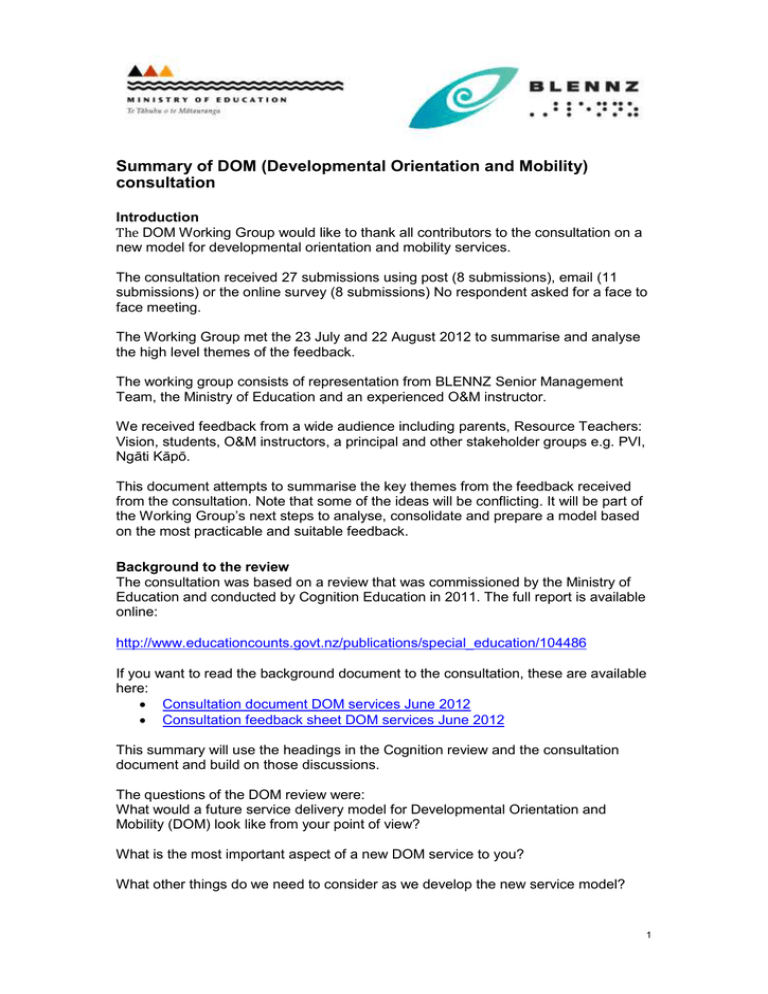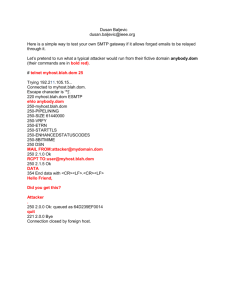here - BLENNZ: Blind and Low Vision Education Network NZ
advertisement

Summary of DOM (Developmental Orientation and Mobility) consultation Introduction The DOM Working Group would like to thank all contributors to the consultation on a new model for developmental orientation and mobility services. The consultation received 27 submissions using post (8 submissions), email (11 submissions) or the online survey (8 submissions) No respondent asked for a face to face meeting. The Working Group met the 23 July and 22 August 2012 to summarise and analyse the high level themes of the feedback. The working group consists of representation from BLENNZ Senior Management Team, the Ministry of Education and an experienced O&M instructor. We received feedback from a wide audience including parents, Resource Teachers: Vision, students, O&M instructors, a principal and other stakeholder groups e.g. PVI, Ngāti Kāpō. This document attempts to summarise the key themes from the feedback received from the consultation. Note that some of the ideas will be conflicting. It will be part of the Working Group’s next steps to analyse, consolidate and prepare a model based on the most practicable and suitable feedback. Background to the review The consultation was based on a review that was commissioned by the Ministry of Education and conducted by Cognition Education in 2011. The full report is available online: http://www.educationcounts.govt.nz/publications/special_education/104486 If you want to read the background document to the consultation, these are available here: Consultation document DOM services June 2012 Consultation feedback sheet DOM services June 2012 This summary will use the headings in the Cognition review and the consultation document and build on those discussions. The questions of the DOM review were: What would a future service delivery model for Developmental Orientation and Mobility (DOM) look like from your point of view? What is the most important aspect of a new DOM service to you? What other things do we need to consider as we develop the new service model? 1 These questions were intentionally kept broad so that we could capture feedback without pre-empting possible solutions. Strengthening a DOM Practice Model Role release Submissions suggested that it would be appropriate for DOMs to role release – but that specialist O&M would be needed as ‘practice leaders’ or similar role. The model will need to reinforce the roles of family, paraprofessionals, teachers and RTVs so that all these people around the students can work towards maximising students’ outcomes. These outcomes link directly to the core competencies of the New Zealand Curriculum (NZC). For more information on the NZC: http://nzcurriculum.tki.org.nz/ To ensure DOM is part of the learning goals it needs to be incorporated into planning (IEPs) Professional development for parents was also recommended. Resource development DOM practitioners have a role to play in developing information and support materials for parents, teachers and paraprofessionals. Developing online resources and self-help tools for students and families will support and enhance future DOM service provision. Ongoing improvements Best practice approaches that build on international best practice and appropriate within the New Zealand context will need to be identified and developed. This will need to be included in the planning of the development and rollout of the model and be built including ongoing improvements of the model. Strengthening the Workforce Strengthening the profession and workforce was seen as one of the keys to success as there is only a very small existing workforce of O&M instructors. There were a number of different suggestions to the level of qualifications or model for Orientation and Mobility specialist including: post graduate training (module or separate course) through to achieving NZQA credits through an apprenticeship model The ongoing professional development and support of the RTVs, teachers and paraprofessionals came through strongly this also included the need for consideration of national DOM practitioner networks and practice advisors or similar roles. The potential for training courses or modules for teachers and paraprofessionals to become trained to support DOM programmes e.g. OMA (Orientation and Mobility Assistants) 2 The need for fair and consistent employment conditions (salary, working context, access to professional development, teaming arrangements) was stressed. It was also seen as pivotal to ensure that roles and responsibilities are clarified between all people involved in the DOM services. This includes transitions between services provided early childhood services by RNZFB (funded by the Ministry of Health) and BLENNZ, as well as between all the different professional groups. Parents and community need to understand these roles and their own roles to be able to support programmes appropriately. The possibility of supporting further study through Special Education administered study awards (this could include incentives for Māori and/or Pasifika staff). Meeting the Needs of Māori A well functioning DOM service would meet the needs of Māori students and their whānau. Stakeholder feedback suggests that a well functioning DOM service would take a holistic, integrated approach working closely and appropriately with all families. Building strong links with Ngāti Kāpo was stressed to ensure that the new model meets the need of Māori. DOM services to be based on the principles of whānau ora and be available in a Māori immersion setting. Meeting the Needs of Pasifika Families To be culturally responsive was one of the key themes in the submissions. We will need to find out more about more about service engagement with Pasifika families and build in ways to collect this feedback as part of the implementation of the new model. Transitions from Early Childhood Education to School Currently, DOM service for young children (under 5) prior to their going to school are funded by the Ministry of Health and provided by RNZFB. Transitions are important and work needs to be done to ensure that there are effective transition processes in place for all children between the DOM services provided by RNZFB and any other school-age based DOM service. The transitions were seen as a very important area of work and especially ensuring that the services before school line up with the new model. The RNZFB have developed a new model Parent and Child Enrichment (PACE) but at this time there is not enough understanding of how the PACE model and the new 3 DOM model interface. The relationship between the two models will need to be clarified. Transitions from School to Post School Environments Currently, RNZFB and a range of other providers are contracted to support transitions from school to work or other education. There is a lack of clarity as to where DOM services feature in these arrangements with a number of organisations working in this context. There is a view that some blind and low vision students do not have adequate consideration given to the DOM needs at this crucial point with the consequence that this could impede their independence. Additional considerations A few submissions touched on areas that had not explicitly been discussed in detail in the review report or the consultation document. These have been collated here: Responsibilities including legal liability of the DOM. The importance of good communication between staff and teams, to parents and students. Proactive service built on good relationships – ‘build the relationships first’ Safety (e.g. road crossings) was one of the parents’ main concerns. The principles of the new model All of the principles suggested by the DOM review and the DOM consultation were echoed in the submissions. These were: Child and family/whānau centered. Needs and outcomes driven. Evidence based Include planning for effective transitions (e.g. between pre-school, compulsory school, post schools, between schools). Well managed to ensure maximum return for funding. Realistic in terms of funding in our fiscally constrained environment. Based on international best practice adapted to our New Zealand context. Proactive rather than reactive Assessment and programming iterative process not discrete contract driven packages Staffed with well trained, efficient and effective professionals including cultural competence. 4 Well integrated into educational contexts and wrap around the student/family and whānau. Focused on children’s early years and whole of life needs to establish strong learning foundations as it is a life skill. In addition, these principles and themes were added or emphasised through the submissions: A model that builds confidence and belief Geographic spread including equity or access throughout the network. Consistent, regular and timely services Collaborative and holistic service Considerations of ADL (adaptive daily living) Whole of life perspective Flexible to meet the needs of different groups including being culturally responsive to Māori and Pasifika A high quality service provided by qualified staff Continuity of staff Working relationships clear with occupational therapists or other SE specialists. The importance of teaming 5







